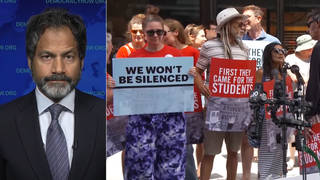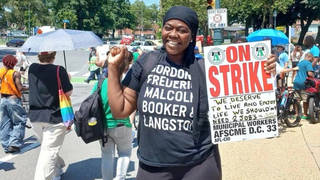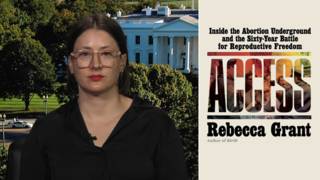
Topics
Guests
- Gary Morminohistory professor at the University of South Florida in St. Petersburg. His books include Land of Sunshine, State of Dreams: A Social History of Modern Florida. He was the one who first described Florida as a Ponzi state.
Florida has been hit particularly hard by the recession. It’s facing its worst unemployment rate since 1976, with nearly one in ten people out of work, and it has the second-highest foreclosure rate in the country. Florida has also been described as one of the birthplaces of the financial crisis. We speak with University of South Florida Professor Gary Mormino, who describes the state’s economy as a giant Ponzi scheme. He’s the author of Land of Sunshine, State of Dreams: A Social History of Modern Florida. [includes rush transcript]
Transcript
AMY GOODMAN:
We are broadcasting from the PBS station in Tampa, Florida, WEDU. As we turn now to the Sunshine State, which has been particularly hard hit by the recession. It’s facing its worst unemployment rate since 1976, with nearly one in ten people out of work. And it’s the second-highest foreclosure rate in this country.
Just a few years ago, Florida was at the center of the real estate boom. But in 2007, it all went bust. Houses stopped selling, foreclosures multiplied, unemployment began to skyrocket. Florida has been described as one of the birthplaces of the financial crisis.
University of South Florida professor, Gary Mormino, describes the state’s economy as a giant Ponzi scheme. He’s the author of Land of Sunshine, State of Dreams: A Social History of Modern Florida. Gary Mormino joins me now here in Tampa, Florida.
Welcome to Democracy Now!, Professor Mormino.
GARY MORMINO:
Thank you.
AMY GOODMAN:
A giant Ponzi scheme?
GARY MORMINO:
Well, I think you can look at this two ways. The first, named after Charles Ponzi in the 1920s, the idea of the confidence game, Bernie Madoff — there was no shortage of financial shenanigans in Florida.
I was referring it to more as a metaphor, that since the 1950s, Florida has been attracting about a thousand people every single day, 85 million tourists last year. Our entire structure, our tax structure, is built upon growth. And the mantra has always been, “growth will pay for itself.” No one ever really, I think, gave serious attention to the fact — what will happen when a thousand people stop coming? And that’s what I meant by the Ponzi scheme, that yesterday’s homeowners will pay for today’s newcomers. And the newcomers stopped coming about two years ago.
AMY GOODMAN:
In his interesting piece in The New Yorker that uses your term “the Ponzi scheme,” George Packer writes, “Only Nevada has a lower proportion of native residents than Florida,” the state’s growth machine not depending on higher education or high-paying professional jobs, but “on real estate and sunshine.”
GARY MORMINO:
Very true. We have no state income tax. Everything is dependent —
AMY GOODMAN:
No state income tax.
GARY MORMINO:
No state — it’s a constitutional amendment. We will probably never have a state income tax.
AMY GOODMAN:
One of only nine states that doesn’t have income tax.
GARY MORMINO:
Exactly. And about one of three Floridians is a native, second lowest in the Union. Someone said the state license plate should be “Where Everyone Is from Somewhere Else.” This has created great problems for the state in connecting — making Floridians believe they have a sense of place here. And that’s one of the great challenges, I think, to modern Florida: a sense of shared sacrifice and a commitment to the future.
AMY GOODMAN:
Professor Mormino, describe how the crisis, the economic meltdown, has affected Florida in the last two years. I mean, you talk about it, in a sense, as being ground zero for the meltdown.
GARY MORMINO:
Well, it is true. I mean, it’s no coincidence that when journalists from The New Yorker, New York Times, Canadian Broadcasting Corporation, they came to the Tampa Bay area — Dateline — Wesley Chapel in Pasco County, Cape Coral in Lee County, places like that — these are instant cities, places that were not even on a map sixty years ago, and they simply burst over night. The largest city, in fact, on the Gulf Coast, south of Tampa, is Cape Coral now. It was 160,000 people a few years ago. It has something like 30,000 unsold homes. I may be low-balling it, in fact.
But the people simply stopped coming, compounded by a national recession, a banking crisis. Retirees, the dependable source of new home ownership in Florida — retirees can’t sell their home in Iowa or New Jersey; they can’t come. So, Florida has really taken a pummeling.
AMY GOODMAN:
Right now, the actual descriptions of people throughout Florida, the foreclosures, the idea of Florida having been, well, governed by one Bush at the same time that the country was being governed by another Bush, how that impacted the economic policies, impacted where you are today here?
GARY MORMINO:
Well, I’m not sure you can blame it on any one individual. I mean, this is a systemic crisis. Floridians have themselves to blame, in many ways, for not demanding a more sensible tax structure.
In some ways, the great crisis now is how do you recreate a Florida dream? I mean, Florida was founded upon the idea of a dream. It’s a combination of the American dream at the larger level and the Florida dream, that you can come to Florida, you’ll have a better life, at least better Februarys. In retirement, you can have dignity in old age. And Florida was cheap.
Florida is no longer cheap. We have lots of environmental, economic problems. And I think one of the great challenges — I think it could be a creative one — is how do we refashion a new dream? What will the new Florida dream be like? And I think America, in general, is also facing many of those challenges.
AMY GOODMAN:
Can you talk more about what you feel needs to happen here?
GARY MORMINO:
Well, what needs to be happening — you know, as a historian, my objectives probably won’t be happening. We need a more sensible tax structure. It’s a very regressive tax structure founded upon growth and sales taxes. We tried a service tax a few years ago; that did not work out. For all purposes, we’re not going to have an income tax, a state income tax, because it’s a constitutional amendment. Half the legislature would have to ask for a vote, and then 50 percent of Floridians would have to vote themselves a state income tax. And part of this is that millions of Americans have sought kind of a refuge in Florida, because it’s cheap. For some, it’s a tax haven; for others, it’s a last stop, dignity in old age and all those things.
We’re at a crossroads right now. And I think two things will happen. We will have a collective dialogue, and we’ll have maybe a greener Florida. Or, as what I fear is that — and you’re already seeing this in the state legislature — some politicians are arguing, now is — we will die without a thousand newcomers arriving, we need to encourage even more growth, we have to get rid of growth management laws, we have to get rid of environmental standards, we have to dampen impact fees, things like that. And that’s likely to happen, because the legislature is a very conservative legislature.
AMY GOODMAN:
Professor Mormino, the headline of your latest article was an interesting one: “Apocalypse Florida: Florida’s Top Historian Files a Report from the Future.”
GARY MORMINO:
Well, that article was written in jest. But like a lot of satire, there’s a germ of truth there, that Florida’s very vulnerable right now. I mean, in some ways, we’ve been lucky. We haven’t had any serious hurricane since 2004, although some would argue a good hurricane is exactly what we need, with all that insurance money pouring into the state.
But Florida — America and the world all face crises of rising energy prices and global warming. Florida is impacted by those even more severe. We have a very shallow coastline. A one-foot rise in sea level could be catastrophic for Florida. We were built with the automobile. We have relatively little mass transit here. So, a spike in gas prices will affect Florida, as well. So, this “apocalypse now” idea is not just satirical; I mean, it’s a lesson we should heed, perhaps, to prepare for the future.
Yet, this is a bewitching state. It pains me. This does not pleasure me to talk about Florida in such terms. It’s a beautiful state. It’s just extraordinarily diverse and vibrant. And I love the fact that millions of seniors have sought their place in the sunshine here and that not long ago a retired mailman from Chicago could come and live on the water in Florida. It is the American and Florida dream combined.
AMY GOODMAN:
And the retirements, pension plans, how have they been affected, because you’ve got this older state here?
GARY MORMINO:
Well, that’s why people aren’t moving here at a rate of a thousand a day. You know, you could have looked at the tea leaves maybe four or five years ago. And four or five years ago, something like 1,600 people were moving daily to Florida. But if you looked closely, something like 600, 700 were leaving. And people joked there should be an expatriate Florida license plate: “It’s Not What I Thought It Would Be.” You know, it’s too humid, it’s too many immigrants, it’s too loud, it’s spoiled, despoiled, all those things.
AMY GOODMAN:
Your governor, Charlie Crist, has not joined with others, like the New Orleans Governor Bobby Jindal or Alaska Governor Sarah Palin, in rejecting some or all of the stimulus money.
GARY MORMINO:
Right. Governor Crist is a moderate Republican. He’s also a smart politician. He knows Florida is desperate right now. And I think most Floridians applauded Governor Crist in that measure. I mean, I don’t hear many people criticizing him, except on the far right, for taking the stimulus money.
Governor Crist — and I love Governor Crist — but he needs to step up and kind of have a frank talk, I think, with Floridians, that we’re in this crisis together. It’s going to take shared sacrifice, collective pain, but the end will be a better Florida for everyone.
AMY GOODMAN:
And the issue of immigrants? The difference in treatment between the Cubans who come here, the Haitians who come here, the imminent — the threatened deportation of 30,000 Haitian immigrants? How do immigrants help shape Florida today?
GARY MORMINO:
Well, if we were having this discussion thirty years ago, we would be talking about Cubans. The 2000 census was revealing. For the first time, there were more non-Cuban Hispanics than Cubans. The great surge in immigration in the last twenty, twenty-five years has been Mexican and Puerto Rican. They have reshaped Florida. They’ve energized Florida. Places that were staunchly Republican fifteen years ago, such as Osceola County and Orange County in central Florida, are now tilting Democratic. It’s a pan-Hispanic immigration now. No county has been exempt from immigration.
There are now more Hispanics in Florida than African Americans. Historically, there were times in the late nineteenth century when there may have been more African Americans in Florida than whites. So, the Hispanic influence is extraordinary in the state. And were it not for immigration right now, Florida might, in fact, be losing population.
AMY GOODMAN:
Well, Professor Mormino, I want to thank you for being with us. Gary Mormino is a historian at the University of South Florida, where I’ll be speaking tonight at 7:00, as we support the great community radio station WMNF. I’ll be at the Marshall Center at 7:00 tonight and this afternoon in Sarasota at New College, also celebrating a low-power FM station, WSLR, as we continue our community media tour.













Media Options